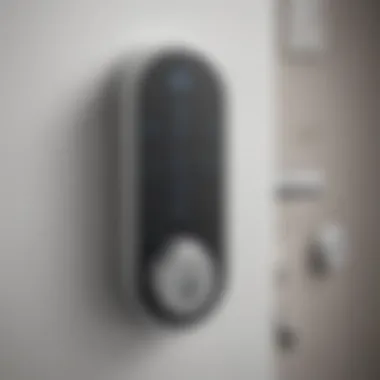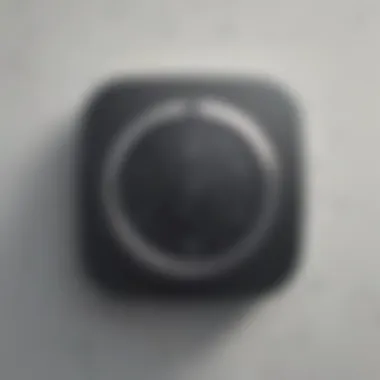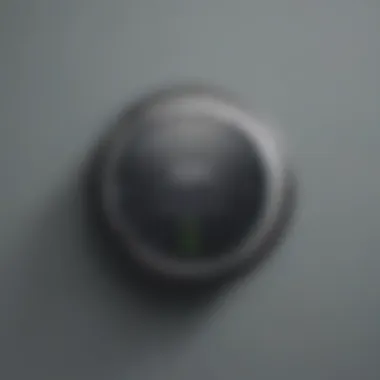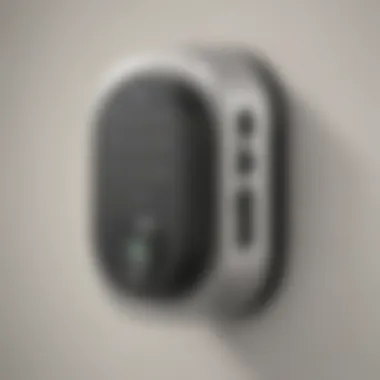Unlocking Home Security: The Impact of Smart Locks on Modern Safety Systems


Overview of Cyber Security Threats
In the realm of home security, cyber threats have evolved to encompass a multitude of insidious dangers that can compromise our safety and privacy. From pernicious malware infiltrations to sophisticated phishing schemes and menacing ransomware attacks, the digital landscape poses a myriad of risks to our household sanctity. The prevalence of these threats is underscored by alarming statistics highlighting the exponential rise in cyber attacks targeting residential spaces, emphasizing the pressing need for robust security measures to safeguard our homes. Real-life examples abound, showcasing the devastating consequences of security breaches that have left many vulnerable to exploitation and intrusion.
Best Practices for Online Security
When fortifying our digital defenses, adherence to best practices is paramount in buttressing our home security. Implementing strong password creation and management techniques acts as the first line of defense against malicious incursions, erecting a formidable barrier to potential breaches. Regular software updates and patches play a crucial role in fortifying vulnerabilities, ensuring that our systems are fortified against emerging threats. Embracing the implementation of two-factor authentication adds an additional layer of protection, enhancing the resilience of our security architecture.
Reviews of Security Tools
In the arsenal of security tools at our disposal, robust evaluation is essential to discerning effectiveness. Assessing the efficacy of antivirus software delineates the capacity of our systems to detect and neutralize malicious entities, bolstering our security posture. Comparing the nuances of firewall protection elucidates the strengths and weaknesses of various mechanisms, guiding us towards the most effective safeguarding strategies. An evaluation of password managers unveils the efficacy of these tools in enhancing password security, streamlining access management while fortifying our digital citadel.
Tips for Ensuring Online Privacy
Beyond security, safeguarding online privacy augments our digital wellbeing. Leveraging Virtual Private Networks (VPNs) for secure browsing encases our online interactions in an encrypted tunnel, shielding our data from prying eyes and potential breaches. Fine-tuning privacy settings on social media platforms curtails the dissemination of personal information, fortifying our online presence against unwarranted exposure. Vigilantly protecting personal data during online transactions fortifies the integrity of sensitive information, fortifying our digital transactions against potential threats.
Educational Resources and Guides
Empowering oneself with educational resources and guides serves as a cornerstone of fortifying home security. Accessing how-to articles on setting up encryption tools imbues us with the knowledge to safeguard our digital communications against malicious interceptions. Perusing step-by-step guides on identifying phishing emails equips us with the acumen to discern and evade deceptive tactics aimed at compromising our security. Consulting cheat sheets facilitates rapid enhancement of our online security practices, optimizing our defensive strategies for heightened protection.
Introduction
In the realm of enhancing home security, the advent of smart lock technology has been nothing short of revolutionary. As we navigate through the landscape of modern-day living, the need for robust security measures has become increasingly paramount. Smart locks have emerged as a beacon of innovation, seamlessly blending cutting-edge technology with the fundamental necessity of safety. This article delves into the intricacies of smart locks, dissecting their functionality, benefits, and considerations for implementation.
While traditional lock systems have served us well for decades, the evolution of smart locks represents a paradigm shift in how we perceive and engage with home security. The introduction of key features such as remote access, keyless entry, and activity monitoring has paved the way for a more convenient and secure living environment. Smart locks transcend the limitations of traditional locks, offering homeowners a glimpse into a future where accessibility and protection coexist harmoniously.
Understanding the different types of smart locks adds another layer of complexity to the conversation. Bluetooth-enabled locks, Wi-Fi connected locks, and biometric locks each bring unique functionalities to the table, catering to varying preferences and security needs. Selecting the right type of smart lock involves a nuanced assessment of individual requirements and the existing infrastructure of the property.
As we navigate through this comprehensive guide on enhancing home security with smart locks, it becomes evident that these technological marvels offer far more than just mere convenience. By embracing smart lock technology, homeowners embark on a journey towards redefining the very essence of security in the digital age.
Understanding Smart Lock Technology
Understanding Smart Lock Technology plays a crucial role in comprehending the advancements in home security. By delving into how smart locks have evolved, the value they bring in terms of enhanced convenience, improved security measures, and integration with smart home systems becomes apparent. Knowing the ins and outs of smart lock technology aids in making informed decisions when considering them for your home.


Evolution of Traditional Lock Systems
The Evolution of Traditional Lock Systems signifies a shift from mechanical to digital solutions. Traditional locks relied on physical keys for access, whereas smart locks utilize innovative technologies like biometrics and remote access. This transition represents a significant milestone in home security, offering a more sophisticated and customizable approach to protecting living spaces.
Key Features of Smart Locks
Remote Access
Remote Access is a key feature of smart locks, allowing homeowners to control and monitor their locks from anywhere. This feature not only enhances convenience but also provides added security by enabling users to grant access to others remotely. Its wireless connectivity ensures seamless operation and peace of mind.
Keyless Entry
Keyless Entry eliminates the need for traditional keys, offering a secure and convenient way to enter homes. Users can unlock doors using codes or biometric data, reducing the risk of unauthorized access. This feature enhances security measures while simplifying the entry process for homeowners.
Activity Monitoring
Activity Monitoring keeps a record of door interactions, offering valuable insights into who enters and exits the property. This feature contributes to enhanced security by allowing homeowners to track access history. Moreover, activity monitoring provides peace of mind by offering real-time updates on door activity.
Types of Smart Locks
Bluetooth-Enabled Locks
Bluetooth-Enabled Locks utilize Bluetooth technology for door access, offering a secure and reliable connection. Users can control these locks via their smartphones, adding a layer of convenience to home security. While convenient, the range limitations of Bluetooth may be a consideration for larger properties.
Wi-Fi Connected Locks
Wi-Fi Connected Locks connect to the home network, allowing remote access and control over the internet. This type of smart lock offers extensive compatibility with smart home systems, enhancing overall connectivity. However, the reliance on Wi-Fi connectivity may pose security risks if not properly protected.
Biometric Locks
Biometric Locks employ unique biological traits like fingerprints or retinal scans for access. These locks offer a high level of security due to the individuality of biometric data. While biometric locks provide unparalleled protection, they may come with higher costs and maintenance requirements.
Benefits of Smart Locks


Smart locks are a pivotal element in modern home security systems, reshaping how individuals safeguard their living spaces. The integration of smart locks brings a myriad of advantages, revolutionizing traditional security measures and elevating the overall fortification of homes. One of the key benefits of smart locks is the heightened convenience they offer, streamlining access to properties while enhancing security protocols. With the advancing technology embedded in smart locks, users can bid farewell to traditional keys and embrace keyless entry systems, transforming the way they interact with their homes. Furthermore, smart locks provide a comprehensive approach to home security by enabling remote access features, allowing homeowners to monitor and control their locks from anywhere in the world. These conveniences combine to create a sophisticated security infrastructure that adapts to the dynamic needs of modern lifestyles.
Enhanced Convenience
Enhanced convenience is a hallmark feature of smart locks, redefining how homeowners interact with their properties on a daily basis. By incorporating keyless entry mechanisms into the security system, smart locks eliminate the need for physical keys, reducing the risk of unauthorized duplication or loss. Users can effortlessly unlock their doors using alternative methods such as smartphone applications or biometric scans, providing a secure and seamless entry experience. Moreover, the remote access functionality of smart locks enables individuals to grant temporary access to guests or service providers with ease, enhancing the overall flexibility and accessibility of the home.
Improved Security Measures
In addition to convenience, smart locks significantly bolster security measures within residential settings. Traditional locks are susceptible to various vulnerabilities, such as lock picking or unauthorized key duplication, compromising the safety of the premises. Smart locks mitigate these risks by incorporating advanced encryption protocols and authentication mechanisms that are challenging to breach. Furthermore, the real-time activity monitoring capabilities of smart locks allow homeowners to track entry and exit logs, providing valuable insights into who accessed the property and when. By enhancing visibility and control over access points, smart locks serve as a proactive deterrent against potential security breaches.
Integration with Smart Home Systems
Smart locks seamlessly integrate with existing smart home systems, amplifying the overall efficiency and interconnectedness of residential automation. Through integration with home assistants like Amazon Alexa or Google Home, users can effortlessly incorporate lock controls into their centralized smart home ecosystem. This synergy enables synchronization between security protocols, lighting settings, and surveillance systems, fostering a comprehensive approach to home management. By leveraging the interconnected capabilities of smart devices, homeowners can achieve a harmonized living environment that prioritizes both security and convenience.
Factors to Consider Before Installing Smart Locks
When delving into the realm of smart home security, considering various factors before installing smart locks is paramount to optimizing safety and convenience. Understanding the intricacies of these factors aids in selecting the most suitable smart lock system for your home.
Compatibility with Existing Doors
One crucial aspect to ponder upon is the compatibility of the chosen smart lock with the existing doors of your home. Assessing the dimensions, material, and lock configuration of your doors is imperative to ensure a seamless integration of the smart lock without necessitating major renovations or adjustments. Compatibility issues may lead to inefficiencies and compromise the overall security of your home.
In addition, examining the door's structure and frame is vital to ascertain whether the smart lock's installation will be structurally sound and reliable. Compromising on compatibility may render the smart lock ineffective and pose a potential risk to the security of your residence.
Power Source and Battery Life
Another critical consideration is the power source and battery life of the smart lock system. Opting for a smart lock that aligns with your preference for power source - whether battery-operated, hardwired, or solar-powered - is essential to maintain uninterrupted functionality. Ensuring a reliable power source is crucial to prevent instances of lockouts or security breaches resulting from power failures.
Evaluating the battery life of the smart lock is equally important, as prolonged battery life reduces the frequency of battery replacements and enhances the efficiency of the security system. Consistent monitoring and timely replacement of batteries are integral to sustaining the operational efficacy of the smart lock and upholding the security of your home.
Security and Encryption
The level of security and encryption provided by the smart lock system is a fundamental aspect to consider before installation. Prioritizing advanced encryption protocols and robust security measures safeguards your home against cyber threats and unauthorized access attempts. Opting for smart locks with multiple authentication layers and encryption standards fortifies your home's defense mechanisms and bolsters its overall security.


Selecting a smart lock system that adheres to industry security standards and certifications ensures compliance with stringent security protocols and enhances the integrity of your home security network. Vigilance in evaluating the security features of smart locks mitigates potential vulnerabilities and reinforces the protection of your living space.
Installation and Maintenance Guide
In this comprehensive guide on enhancing home security through smart locks, the Installation and Maintenance Guide plays a pivotal role in ensuring the optimal performance and longevity of these advanced security systems. It is crucial to understand the meticulous process involved in installing and maintaining smart locks, as any misstep could compromise the overall security of your home. This section delves into the specific elements, benefits, and considerations regarding the Installation and Maintenance Guide, providing invaluable insights for homeowners seeking to bolster their security measures.
Step-by-Step Installation Process
The Step-by-Step Installation Process of smart locks is a meticulous procedure that demands precision and attention to detail. From selecting the ideal location on your door to ensuring proper alignment and calibration, each step is crucial in guaranteeing the effectiveness of the smart lock. This section will outline the intricate process of installing a smart lock, including preparing the door, mounting the lock mechanism, and syncing the device with your smartphone and existing security system. By following these detailed instructions diligently, homeowners can successfully integrate smart locks into their home security infrastructure.
Regular Maintenance Tips
Regular Maintenance is paramount in preserving the functionality and durability of smart locks. Over time, factors such as dust accumulation, battery depletion, and wear and tear can impact the performance of these sophisticated security devices. This section will offer practical tips on how to maintain smart locks, including cleaning the sensors, replacing batteries routinely, and performing system checks to ensure optimal functionality. By adhering to these maintenance guidelines, homeowners can prevent potential malfunctions and uphold the reliability of their smart lock system.
Enhancing Overall Home Security
Enhancing overall home security plays a pivotal role in the quest for a safe living environment. As technology continues to advance, traditional methods of securing homes are being replaced by more sophisticated solutions like smart locks. These innovative devices offer a multifaceted approach to fortifying home security, by integrating seamlessly with existing systems to provide enhanced protection.
Smart locks not only elevate the convenience of access control but also bolster the overall safety measures of a property. By incorporating features such as remote access, keyless entry, and activity monitoring, these locks offer a comprehensive security solution that surpasses the limitations of conventional lock systems. This integration of modern technology with home security goes a long way in ensuring that homeowners can rest easy, knowing that their living spaces are well-protected.
Complementing Security Systems
Smart locks serve as a valuable addition to existing security systems, enhancing their effectiveness and usability. By integrating smart locks into a wider security network, homeowners can create a comprehensive protective shield around their property. These locks can communicate with other smart devices, such as security cameras and alarm systems, to create a synchronized security infrastructure that responds proactively to any potential threats.
The compatibility of smart locks with other security technologies allows for a seamless integration that fills potential gaps in a home's defenses. For instance, in the event of an unauthorized entry attempt, the smart lock can trigger the alarm system and alert the homeowner immediately, enabling swift action to be taken. This complementary relationship between smart locks and security systems strengthens the overall protective measures of a home, offering a holistic approach to safeguarding against intrusions.
Peace of Mind for Homeowners
The primary impact of smart locks on homeowners is the unparalleled peace of mind they provide. With the knowledge that their homes are equipped with advanced security measures, including smart locks, homeowners can go about their daily lives without the constant worry of unauthorized access or break-ins. This sense of security translates into a tangible peace of mind that enhances their overall quality of life.
Moreover, smart locks offer remote access capabilities, allowing homeowners to monitor and control their locks from anywhere, at any time. This remote management feature adds an extra layer of convenience and peace of mind, as homeowners can verify the status of their locks and secure their homes even when they are away. Ultimately, the incorporation of smart locks fosters a sense of assurance and tranquility among homeowners, knowing that their living spaces are fortified with cutting-edge security technologies.
Conclusion
In this final section, we encapsulate the crucial considerations and significance of implementing smart locks for enhancing home security. As we have journeyed through the evolution of traditional lock systems to understanding the key features and types of smart locks, it becomes evident that smart locks offer a paradigm shift in securing our living spaces. The integration of smart locks is not merely about convenience but also about bolstering the security measures of our homes.
One of the pivotal aspects to emphasize in this conclusion is the enhanced security and peace of mind that smart locks bring to homeowners. Unlike traditional locks, smart locks provide a heightened level of security through features such as remote access, keyless entry, and activity monitoring. This advanced technology ensures that homeowners can monitor and control access to their homes, even when they are away, thus minimizing the risk of unauthorized entry.
Moreover, smart locks seamlessly integrate with smart home systems, allowing for a comprehensive approach to home security. By connecting with other smart devices such as cameras, alarms, and sensors, smart locks contribute to a cohesive security ecosystem that functions harmoniously to safeguard our homes. This integration not only enhances the overall security measures but also offers homeowners a streamlined and efficient approach to managing their home security.
Furthermore, considering the compatibility of smart locks with existing doors, power sources, and encryption protocols before installation is fundamental. These factors ensure that the smart lock system functions optimally and provides the intended level of security. By addressing these considerations proactively, homeowners can maximize the benefits of smart locks and fortify the security of their residences.







